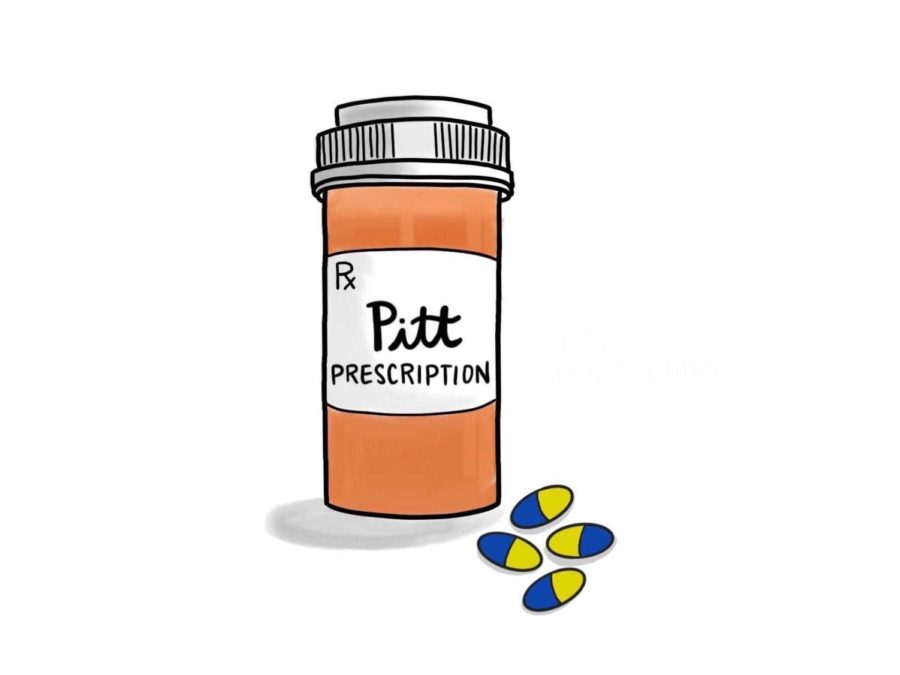The Pitt Prescription | Be on the lookout: Best practices for at-home eye care
The Pitt Prescription is a biweekly blog where student pharmacist and senior staff writer Elizabeth Donnelly provides tips on how to stay healthy in college. This edition was reviewed by Karen Pater, PharmD., CDCES, BCACP.
Shruti Talekar | Contributing Editor
The Pitt Prescription
January 28, 2022
Right before winter break, I noticed that my vision wasn’t as good as it used to be, especially over long distances. I realized I could no longer read the captions on my TV clearly and that I had trouble seeing street signs from distances where it used to be no problem. I decided to get an eye exam when I went home, and I’m very glad I did.
At my appointment, the optometrist discovered that I had developed nearsightedness and now needed glasses to correct my distance vision. I was initially surprised — I was always told that I had 20/20 vision. I wondered how this could happen when I was previously fine, and that’s when I found out that this change in vision was likely due to my screen time.
The optometrist sat me down and explained that she has seen a rise in cases just like mine recently. She thinks this trend is the result of college students spending long periods of time intensely focused on near work, like when studying. While there is a potential for my nearsightedness to reverse, she explained that if I continue to focus on screens or other small objects closely, it will most likely remain as a permanent eye disorder. However, this isn’t a rare case, since many people develop nearsightedness for the same reasons.
During the COVID-19 pandemic, young individuals are using electronic devices more frequently, and as a result, the amount of screen time people average daily is at an all-time high. Numerous studies have shown that working up close — like using a laptop to write or read — is directly associated with the potential to develop myopia, otherwise known as nearsightedness.
Myopia is a common eye disorder that affects roughly 25% of Americans, and it occurs when the eye either focuses too strongly or if the eyeball is misshapen. When either of these occur, light focuses in front of the retina instead of on it, causing vision to become blurry. Although it is a common disorder, if it is severe enough myopia may increase the risk for several eye issues in the future, such as glaucoma, cataracts or retinal detachment.
A 2015 study found that the prevalence of myopia has significantly increased recently worldwide, and in highly educated groups, like law or medical students, it exceeds 80%. For students obtaining a college education, this is especially pertinent. Researchers believe that activities done at a short working distance such as studying, reading, general computer and smartphone use, among others, increase the risk of myopia development. This includes attending Zoom classes, which many, if not all, of us have done over the past year and a half.
Fortunately, it appears classes are moving back to a primarily in-person teaching model. However, the risk of eye strain during in-person education is still present. Therefore, it is important to identify the possible risk factors associated with the development of myopia, and how to prevent them when possible. Catching eye disorders and diseases early on is one of the most important ways to minimize the risk of further complications.
While adults under age 40 aren’t required to get routine eye exams, there are some circumstances for which the CDC recommends going to an eye doctor. First, anybody with diabetes should get an annual eye exam because of an increased risk for eye damage associated with high blood sugar. Additionally, people of any age with any of the following issues should see an eye doctor immediately — decreased vision, redness in the eye, eye pain, double vision, specks that appear to float in front of the eyes, seeing circle or halo shapes around lights or seeing random flashes of light. Finally, people with a family history of eye disorders or disease should be seen at least every two years for an eye exam.
Other than receiving a comprehensive eye exam, there are some at-home measures that can help to improve eye health and reduce risk factors. Like many other bodily systems, eye health is dependent on your overall health, according to the National Eye Institute. Individuals with suboptimal habits have the potential to develop eye diseases easier than those who have a balanced lifestyle.
Conditions like obesity and high blood pressure are directly linked with worse eye health, so forming healthy habits is key. Eat a healthy and well-balanced diet consisting of dark, leafy greens. Foods with omega-3 fatty acids, like fish, are also good for eye health. Additionally, being active helps lower the risk of health conditions that may cause vision problems. The CDC recommends that adults get at least 150 minutes per week of moderate intensity activity to stay healthy, but more is encouraged. One 2019 study suggests that just getting outside for two hours per day may decrease the risk of myopia. Another at-home tactic is to quit smoking or vaping. While smoking mainly attacks the lungs, it can also harm the eyes and increase the risk of diseases like macular degeneration.
There are also specific actions that can be taken to improve eye health and safety. Experts recommend wearing protective eyewear whenever possible. This means wearing goggles while swimming, sunglasses outside even during the winter months and safety glasses when playing sports or doing other potentially dangerous activities.
Additionally, many professionals recommend the 20-20-20 method — after each 20 minutes of screen time or intense close-up focus, look at an object 20 feet away for at least 20 seconds. This allows your eyes to rest and reset from the strain on them that close focus causes. Finally, try to avoid straining your eyes when possible. This means no reading in dark rooms and increasing font size when necessary.
Although it may not seem like much, these techniques may significantly lessen the risk for eye disorders and diseases. When in doubt, always reach out — never use products in your eyes without consulting a specialist and if you have any issues, addressing them early is key.
Elizabeth writes primarily about self-care and pharmacological topics. For questions, comments or concerns, you can reach her at [email protected].








